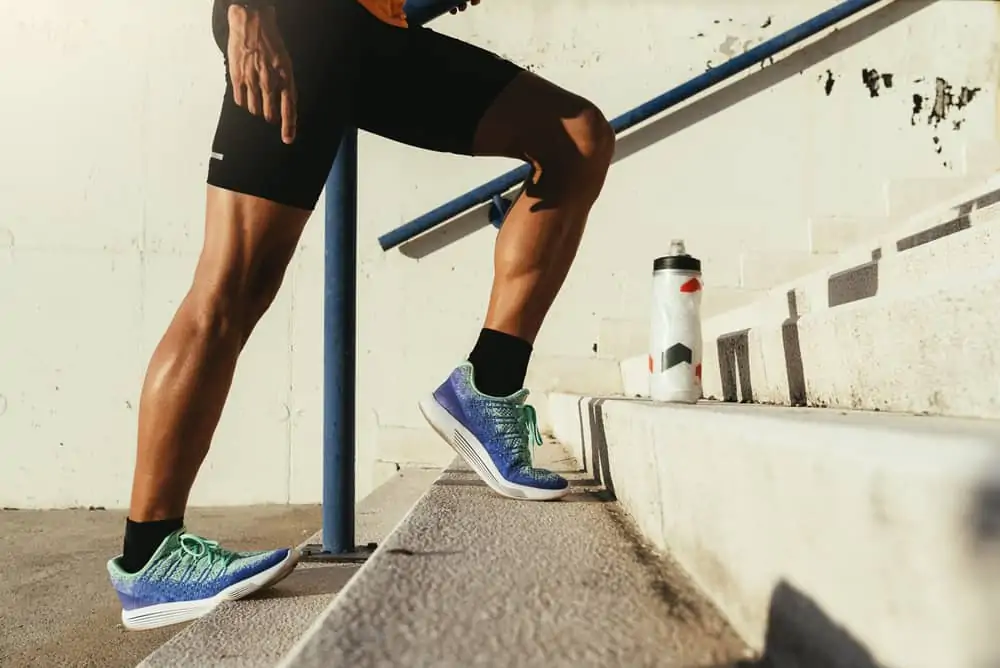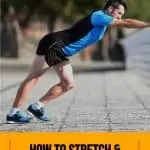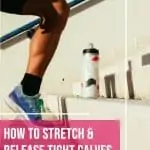This post may contain affiliate links. If you click through a link and make a purchase, I may receive a commission at no additional cost to you. As an Amazon Associate, I earn from qualifying purchases. Read the full disclosure here.
Got super tight calf muscles that never seem to loosen up?
The calves and feet get a lot of work during the day. As long as we’re standing, those muscles are constantly working to keep us balanced and propel us forward with walking or running.
Muscles can feel tight for a variety of reasons including overuse, fatigue, shoe choices, injuries, joint mobility restrictions, muscle weakness, or imbalances.
Tight calves can even lead to other injuries like plantar fasciitis, shin splints, or Achilles tendonitis.
Today, you’ll learn a variety of ways to stretch, mobilize, release, and strengthen your tight calves so you can move and feel better.
*Friendly PSA – If you have new onset pain, swelling, or are unsure if these exercises are right for you, get evaluated by your doctor or physical therapist before trying to fix your calf tightness on the internet.*
Disclaimer: This content is for educational purposes and is not medical advice. Read the full disclaimer.
Calf muscle anatomy
The calf muscles are located at the back of the lower leg. The gastrocnemius muscle crosses the knee joint, which is essential to note for optimal stretching and strengthening positions.
Beneath the gastroc is the soleus. Together these muscles fuse into thick fascia that becomes the Achilles tendon, ultimately attaching at the back of the heel.
The calf muscles function to plantarflex (point) the foot and rise up on your toes. The gastroc assists with running and jumping as well as pushing off when you’re walking.
These muscles also help with the first line of defense in keeping your balance during small postural sways.

What’s the best calf stretch?
Believe it or not, there are a lot of different ways to stretch your calves.
Here are two basic examples of a gastroc and soleus stretch. The main difference between these two stretches is the knee position.
Gastroc calf stretch

- Stand near a doorway or wall and take a long step backward with the leg you wish to stretch.
- Place your hands on the wall and press deeply into the back heel, keeping the knee extended.
- Adjust your stance to a comfortable length that works for you.
- Hold 20-30 seconds
- Repeat 2-3 times.
Soleus calf stretch

- Stand near a doorway or wall and take a step backward with the leg you wish to stretch.
- Place your hands on the wall and press the heel down with a slight bend in the knee.
- You may notice the stretch feels lower down the leg as opposed to the gastroc stretch.
- Adjust your stance to a comfortable length that works for you.
- Hold 20-30 seconds
- Repeat 2-3 times.
My favorite way to do these stretches is with a slant board. I really feel like I get a great stretch whenever I use one.
A slant board can be adjusted to provide different levels of intensity based on your flexibility. With a slant board, it’s easier to relax your calf muscles and use gravity to settle into a deep stretch.
This slant board on Amazon has an adjustable height, so you can change the level as your flexibility improves.

The other crowd favorite is the Prostretch. The Prostretch comes in both a single or a double and allows you to rock your heel back for a deeper stretch.

Both of these tools are favorites for those dealing with tight calves, plantar fasciitis, or Achilles tendonitis.
Remember, with stretching, less is more. Overstretching can lead to a protective response that doesn’t allow the muscles to relax and get the benefit of the stretch.
For more variations on these stretches, check out the ankle and foot flexibility library.
Mobility exercises for tight calves
Ankle dorsiflexion (pulling the toes toward you) isn’t just limited by calf flexibility, but by joint mobility at the ankle. Muscles can only stretch so far and can be limited by the available range of motion at the joint.
Here’s a great video by Precision Movement on YouTube demonstrating four exercises (that aren’t stretches) to improve ankle mobility.
Muscle scraping for tight calves
Muscle scraping comes from a Gua Sha technique using a tool to “scrape” the skin and stimulate blood flow.
Muscle scraping focuses on treating soft tissues of the body, such as muscle and fascia, to improve blood flow, break up scar tissue, and improve mobility with specialized tools. These tools come in a variety of shapes to contour various body parts.
Muscle scraping is an excellent adjunct to your regular routine, along with stretching and mobility exercises for best results.
For tight calves, my favorite muscle scraping tools are the Sidekick Eclipse and the Sidekick Swerve. (The Bow also works well.)
These tools are easy to hold and have contours that work well for the calf muscles.
Check out these two articles to learn more about muscle scraping and my Sidekick tool review.
Trigger point release for tight calves
A trigger point in your calf muscles can make you feel like your calves are really tight. Trigger points or tender points in muscles can be painful and limit your full flexibility.
You can use your hands or a ball to perform a trigger point release on yourself.
This video demonstrates trigger point release for the calves using both a foam roller and a small ball.
I prefer the small ball because it gets a little deeper into the area than a foam roller can, but you’ll have to decide what works best for you.
Strengthen your calves
Many times muscles can “feel” tight when they’re actually weak or compensating for a weakness somewhere else in the body.
Be sure to include calf strengthening exercises like heel raises and other strengthening for the posterior chain (back body, especially the glutes) for strong movement patterns to avoid injury.
How can you test your calf strength?
- Stand on one foot holding on to the wall for balance
- Raise up on your toes and try for at least 10 reptetitions
If you have difficulty performing a calf raise or aren’t able to repeat 10 times, your calves likely need some strengthening.
Here’s Bob & Brad, the “most famous physical therapists on the internet” with a variety of calf strengthening exercises.
Don’t forget to loosen up your feet
The calves and feet work very closely together.
Cramped, weak, and inflexible feet can cause the calf muscles to work harder than they need to.
Rolling your arch on a ball and doing intrinsic muscle strengthening exercises while wearing toe spreaders is a great way to keep your feet mobile and strong.
Other important tips
Calf pain can accompany muscle tension but sometimes needs to be further evaluated to rule out more serious issues.
If you’ve had an injury, such as a calf strain, or notice random onset calf pain or swelling, it’s best to check in with your doctor or physical therapist before trying these exercises.
Calf pain can be related to other more serious conditions including blood clots, but this can be easily ruled out by your healthcare provider.
Wrapping up
Calf muscle flexibility is essential for good movement and is often overlooked.
Try these tips to stretch, mobilize, release, and strengthen your calves to move and feel more flexible and help protect against developing other injuries.
If you’re not sure which of these is right for you, you can always see a physical therapist for an individualized program.








This is really helpful, thank you for the great tips!